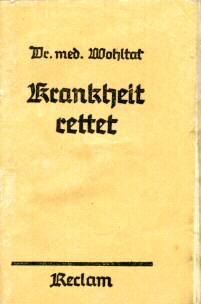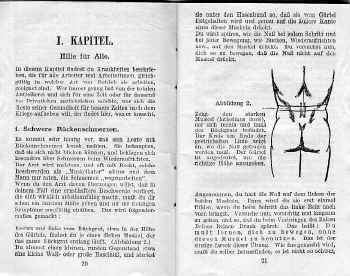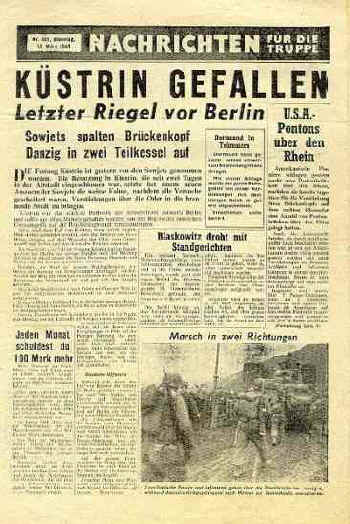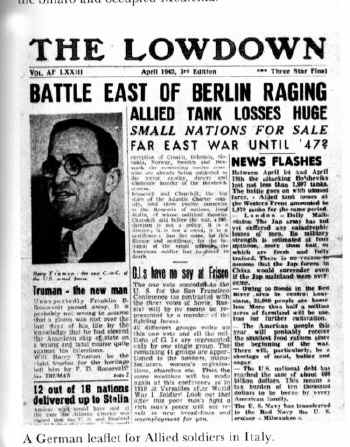|

A paper
by
Robert Rowen
presented to the New
York Military Affairs Symposium
April 18, 2003
The CUNY Graduate
Center
NEW
Now readable & printable in Adobe Reader ‐ click
here

Introduction | Anecdotal Evidence | Definition of
Terms | History & Evolution | Sefton Delmer
The People's
Radio | Gustav Siegfried Eins | Atlantiksender | Reception ‐ a crucial
issue
The Biggest Aspidistra in the
World! | Soldatensender Calais | Deniability | Content
Intrusion Operations | Epilogue | Gray & Black Radio Today | Conclusions | About the
author | Bibliography & Acknowledgements
Introduction
I have often thought that one of the obstacles to creating truly objective military
history is our inclination to write with a subtext that, like in sports reporting, roots for one side or
the other.
In this study of Radio Propaganda against Germany in
WW II, we may not avoid that pitfall, but I would advise the reader and listener that you must be
especially nimble: in this story, our good guys may do some very wicked things. And the bad guys, the
Nazis in this case, may be on the receiving end of some especially nasty lies, disinformation, rumors and
tricks. All concocted by OUR side, often in the interest of turning the inherent weaknesses of the Nazi
state against itself.
A major challenge in researching these, mostly British, operations, was simply that almost all
the related records and documents were destroyed at the very end of the war in Europe, undoubtedly to
avoid the embarrassment that a history of purposeful government lying might be revealed.
The sources for this paper are many bits and pieces plus two biographies: The Black Game
and Black Boomerang by two of the principals who ran the operations. Proving the
effectiveness of their efforts will not be easy. Most of the evidence is anecdotal. But I
found tantalizing indeed the speculation that British radio stations, pretending to be German, may have
influenced the German mindset.
Anecdotal Evidence
on the existence & effect of gray and
black radio
For example, from Goebbels’ Diaries:
|
November 28, 1943
In the evening the so‐called “Calais
Soldiers Broadcast” which evidently originates in
England
and uses the same wavelength as Radio Station Deutschland when the latter
is cut out during air raids, gave us something to worry about. The station does a very clever
job of propaganda and from what is put on the air one can gather that the English know exactly
what they have destroyed and what not.
Joseph Goebbels, The Goebbels
Diaries: 1942‐1943. trans. Louis P. Lochner (Garden City: Doubleday,
1948)
|
Definition of Terms
White propaganda
(clearly identified)
|
BBC, Voice of
America, Radio Berlin
|
“This is
London
calling”
VOA plays “Yankee Doodle”
"Germany
Calling"
|
Gray propaganda
(unidentified ‐
who do you think it is?)
|
Not (clearly) identified
|
“Keep listening to “Der Chef”
”This is GS1”
(gray/black)
|
Black
propaganda
(It says it's one thing. It's not.)
|
Radio Concordia (France,
1940)
(It’s a Goebbels
operation)
Official German Radio (It’s not. It’s British
pretending to be Official German Radio.)
|
“This is Radio
Concordia”
“Hier ist der Reichsender”
|
The meaning of propaganda
and the limitations of this inquiry
I'd like to emphasize that this paper will confine itself to Gray and Black propaganda. This is
NOT about white radio, that is, it is NOT about the BBC, or Lord HawHaw, or Axis Sally, Tokyo Rose, or
Nazi jazz from Hamburg, on radio stations which clearly identified themselves, and about
which much has been written. Note that the problem with these WHITE sources evidences the very reason
GRAY & BLACK radio stations were created: that is, “London Calling”, “Yankee
Doodle” and Radio Berlin were labeled in the mind of the listener on the
other side: ENEMY PROPAGANDA. Think of the way that the very word, propaganda, is intoned in
American English: “Why that’s just propaganda!” meaning untrue, slanted, and in the
interest of the enemy and not in your own country’s interest. Even if a white radio
station, like the BBC, were to have listeners, say in Germany, chances are they'd be
anti‐Nazi Germans to begin with and broadcasting to them would be preaching to the converted.
Gray and black propaganda evolved precisely to get around this limitation of white propaganda
Keep in mind that white propaganda, from Berlin or London, can distort or lie too. In fact, a case
can be made that much of the information on black and gray radio was more truthful than
white. Remember that white propaganda says "I" and "you" while gray and black
propaganda says "we". The head of British gray and black propaganda said, "we must never
lie by accident." (Cover
with "The Truth" on its head from the Calvin website at http://www.calvin.edu/academic/cas/).
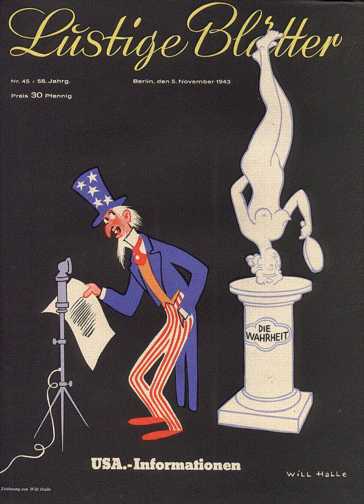
|
German weekly humor magazine
Lustige
Blätter (Merry Pages)
shows statue of "The Truth" on its
head.
|
Nazi Minister of Propaganda Josef Goebbels considered his own propaganda vital and, remembering
the upheavals in Germany in the wake of WW I, strongly felt that the enemy's propaganda might well
be deadly. In this paper, we will see how Goebbels was able – with a straight‐face –
to ban listening to foreign broadcasts and to make it a patriotic cause to turn in your regular radio
set for a radio with limited receiving power. We will see how a little ‐known, Berlin‐born
British subject, Sefton Delmer, was able to concoct myriad schemes to circumvent Goebbels’ effort;
he even created a situation where Germans, listening to gray and black radio and aware they were
probably from enemy stations, were able, in Plato’s phrase, to willingly suspend disbelief.
The History & Evolution of Gray And Black Radio Propaganda
The origins of gray and black propaganda extend back to Sun Tzu around 500 BC postulating
rumor as a weapon of war. But just before the age of radio, there’s one possibly
significant series of events worth noting: by 1918, Lord Northcliff’s Crewe House in
London had become a factory for all kinds of propaganda aimed at Germans on the Western
Front. In October, 1918 alone, over 5 million leaflets were dropped on German trenches, including a
troop information newspaper of undeclared origin, Heer und Heimat (Army and Homeland), and
subversive pamphlets bound with covers that looked like popular German books. (Jolly) Imagine how this might have contributed to the
post‐World War I “stab‐in‐the‐back” theory or to the mindset of
one German soldier, Adolph Hitler, until he was gassed on October 16th.
In the 1920s and 30s, the public everywhere was entranced with radio. It may be hard, in our
media‐bombed age, to appreciate just how magical it was. Voices in the ether. Folks spent hours
twiddling the radio dial, catching words from the nearest big city or from across the ocean. You might
read one or two newspapers but here, on your radio, were dozens. In real‐time, we’d say
now. Hitler loved radio and Goebbels delivered a paper in 1933 entitled The Radio as the Eighth Great
Power”(Calvin website at http://www.calvin.edu/academic/cas/gpa/goeb56.htm).
Interestingly, most authorities (Howe, et al) agree that the first recorded use of gray or black radio propaganda was Nazi against
Nazi. Between September 1934 and January, 1935, adherents of Nazi renegade Otto Strasser set up a short
wave transmitter in
Czechoslovakia
which claimed it was broadcasting from inside Germany. The short‐lived
venture ended in a hail of gunfire when the Gestapo tracked it down, sent a team over the border, and
killed the chief engineer and destroyed the transmitter.
During the Spanish Civil War, Goebbels supplied a mobile transmitter that worked in the guise
of a Republican station.
And it seems that the Nazis really did start big‐time gray and black propaganda
radio. One month after the attack on Poland, Goebbels’ Ministry for the
Enlightenment of the People and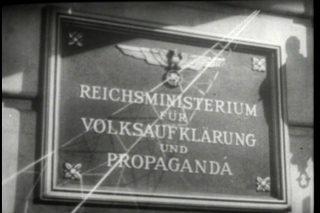 Propaganda added to its domestic and international
services a third section: Bureau Concordia. As the Phoney War evolved into the conquest of France, the
French heard unidentified radio stations which seemed to be Communist urging pacifism and peace and
messages that “France was weak, Germany was strong, and Britain was using France for its own
imperialist purposes (Bergmeier & Lotz) The station would
"reveal" deficiencies in the French armament industry and express concern for the
country's future if the army lost their spirit.(Photo from the
Why We Fight Series, The Nazis Strike, OWI/US Signal Corps, 1943) Propaganda added to its domestic and international
services a third section: Bureau Concordia. As the Phoney War evolved into the conquest of France, the
French heard unidentified radio stations which seemed to be Communist urging pacifism and peace and
messages that “France was weak, Germany was strong, and Britain was using France for its own
imperialist purposes (Bergmeier & Lotz) The station would
"reveal" deficiencies in the French armament industry and express concern for the
country's future if the army lost their spirit.(Photo from the
Why We Fight Series, The Nazis Strike, OWI/US Signal Corps, 1943)
The station would report that the French government fled
the country, leaving the people to fend for themselves and that they "knew" of cholera in
Paris , and "advised" listeners to withdraw their savings from bank accounts and
stock‐pile food. This type of broadcasting continued till France was in a chaotic and
frenzied state. In Goebbels diary he writes, "The minister reported that an analysis made by
our diplomatic services confirms the effectiveness of our broadcasts, that their success is one
hundred per cent, and that the collapse in the enemy camp can be attributed to a major degree to
these broadcasts" ..... On June 24, a couple of days after the surrender of France, the German
secret stations closed down because they had achieved what they had been created to do. (From the German Radio and Fascism in the 1930's website at
http://www.sit.wisc.edu/~pnpoltzer/index.htm)
Shortly after the Fall of France, Goebbels launched the New
British Broadcasting Station, an early project of William Joyce, before he became Lord Haw Haw. The
Germans also ran stations intended for North American listeners, such as Radio Debunk operating from
Bremen tho claiming to be "the Voice of All Free America"
transmitting from the Midwestern United States. "
Sound clip of Radio
Debunk. (From the On the Short Waves
website at http://www.earthstation1.com/Station_D.E.B.U.N.K..html)
When the Nazis’ preparations for the invasion of the British Isles was at its peak,
Goebbels gloated in his diary, on May 29, 1940, "We are stoking up panic...Have pushed secret
stations into top gear...Churchill keeps up the bluster, fear sweats from every pore of his body...We
haven't yet turned up the steam full blast in our broadcasts. Waiting for that until just before
the catastrophe." As it turned out, it was Goebbels who’d be on the receiving end.
The man who’d give it to him
was a man he knew quite well:
Sefton Delmer
During
Hitler’s 1932 election campaign, the Nazi entourage included a British journalist.

Photos by Sefton Delmer, provided by his son Felix Delmer, appeared in
"Black Propaganda" by Mark Kenyon in issue No. 75 of "After the Battle" Used with
permission.
He’s not in these photos. He’s the
photographer who took these photos.
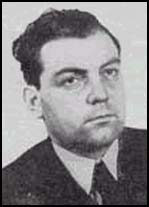 Sefton Delmer was born in Berlin in 1904. His father was an
Australian on the English faculty of The University of Berlin and Sefton grew up to speak German like
a native. He became the German correspondent for Lord Beaverbrook’s Daily Express and
personally knew Hitler, Hess, Goering, Goebbels and Roehm. I recommend to you his account of his
meetings with some of these Nazis at the scene of the Reichstag Fire as a notable work of journalism
of the era (See http://www.heretical.com/miscella/reichstg.html).
Sefton Delmer was born in Berlin in 1904. His father was an
Australian on the English faculty of The University of Berlin and Sefton grew up to speak German like
a native. He became the German correspondent for Lord Beaverbrook’s Daily Express and
personally knew Hitler, Hess, Goering, Goebbels and Roehm. I recommend to you his account of his
meetings with some of these Nazis at the scene of the Reichstag Fire as a notable work of journalism
of the era (See http://www.heretical.com/miscella/reichstg.html).
At the beginning of the war, Delmer, by then in Britain, had to clear
up some doubts about his loyalties. The British thought he might be a German agent or Nazi
sympathizer because he was German‐born and had spent most of his life in Germany. At the same
time, the Germans put him on the Gestapo’s people of interest list that they planned to
use if England was conquered.
(Sefton Delmer's son has began to
publish his father's work on the web. This fulltext undertaking adds previously unpublished
photos and other material to this indispensable work. See http://www.seftondelmer.co.uk/contents.htm)
Most British intelligence and deception operations were run by committee. The Twenty
Committee, the operations surrounding Enigma and even the BBC were committee operations. But Delmer
was a controlling personality who had got the backing from on high to somehow get to the Germans
through the ether, get into German ears, and somehow, get into their minds. That wasn’t
going to be easy.
The People's Radio

Photos in this section from the Antique Radios ‐ Germany
site at antike‐radios.com Used with
permission.
Perhaps remembering how, in 1918, Allied propaganda had shattered German morale and the
cohesiveness of their armed forces, Hitler had Goebbels make a determined effort that Germans would
hear the Nazi voice and not others.
A radio receiver for the people, Volksempfanger VE 301 — whose model number
represents the day on which the Nazis seized power, January 30 — was quickly developed and
introduced in 1933. All German manufacturers were subsequently required to produce models of the
People's Radio set for the standard price of 76 Reichsmarks
Compare this receiver with the kind most Europeans had in the ‘30s and ‘40s
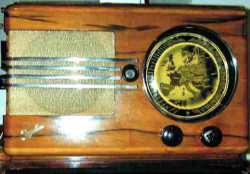 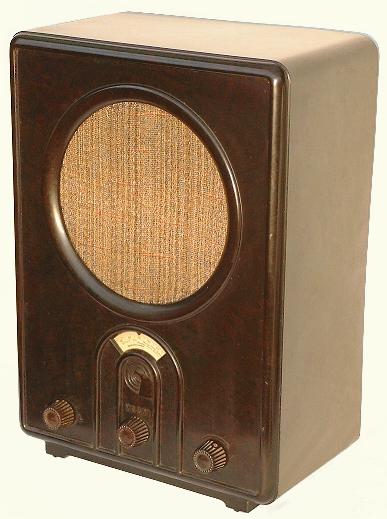
The ordinary radio on the left is
marked for stations all over Europe and had a shortwave band. The
People’s Radio on the right had a simple dial, no shortwave and is only marked for German
frequencies.
In case there’s any doubt, a bright orange tag was hooked to the tuning knob.
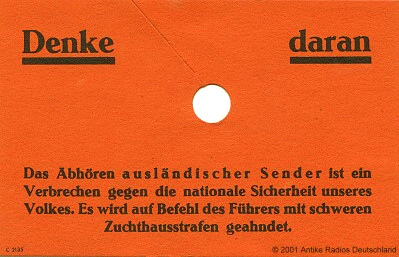
It reads: “Think about this: Listening to foreign broadcasts is a crime
against the national security of our people. It is a Fuehrer Order punishable by prison at hard
labor.
"
Later in the war, listening to foreign radio was punishable by death…but at the
same time, late in the war, the hunger and need for better war information may have made more
Germans take a chance.
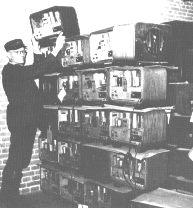 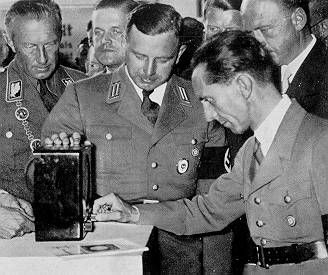
But in the ‘30s in Germany, in a campaign
meant to define if you were a good German or not, people turned in their regular receivers with
which they could receive broadcasts from all over Europe and the world ‐ while no hype was
spared on the People’s radio with limited reception.
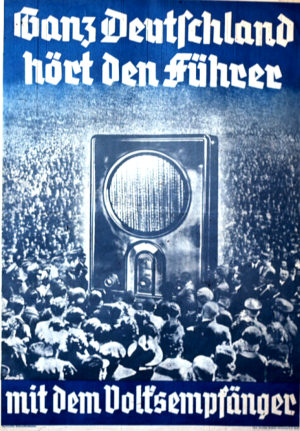
Poster from The German Propaganda Archive at Calvin
College at http://www.calvin.edu/academic/cas/gpa/
A
Poster from the 1930s ‐ All of Germany listens
to the Fuehrer
on the People's Radio
This was "a whispered joke" of the time:
Dear God Make me mute and
dumb,
> that to Dachau, I don't come.
> Dear God stuff up both my
ears,
> So neither one a clear word hears.
> Dear God Make me deaf and
blind
> stop up my nose, befog my mind
> In every way just let me show
>
Our world is wonderful, I know
> Unseeing, deaf and mute and mild,
> I am my
Adolf’s dearest child.
English adaptation and verse by
Philip S. Goodman
Gustav Siegfried Eins
Not many Germans heard the first broadcast of GS1 on
May 23rd 1941 . But for those who did, they
heard the program open, as did so many international broadcasts in WW II, with a series of coded
message like “This is GS1 calling GS18” “This is GS1 calling GS47 ”
followed by a coded message. Then “Der Chef”, the Chief, introduced himself:
He appeared to be a typical diehard loyal old Prussian
Army Officer whose colorful and outspoken views showed him as deeply loyal to the Fatherland, and
indeed the Fuehrer, but severely critical of many of the Nazi policies and conduct of the war.
Above all, he was scathingly contemptuous of the Nazi party rabble that had seized the Fatherland
in the Fuehrer's name. Listeners tuning in would naturally gain the impression that they were
listening to a clandestine German military transmitter broadcasting coded strategic messages and
diatribes from a senior officer who could not contain his opinions any longer. (Michael R Burden, "The Biggest Aspidistra in the
World" http://members.aol.com/skywave48/aspidistra.htm
)
This was pure Sefton Delmer where he drew upon
his years in Germany and his insights into the German personality of the era. Now head of the
British Political Warfare Executive's gray and black propaganda effort, he had no end of
tricks up his sleeve.
Here’s an analysis of just a few elements of a
GS1 broadcast:
|
Broadcast
|
Appearance /
Speculation
|
The truth
|
GS1
(meaning left to the
imagination of the German listener)
|
GS = Gregor Strasser (a “red‐brown” Nazi
shot in the Roehm putsch”)
GS = Geprüfte Sicherheit
German certification mark controlled by the
German Ministry of Labor….
GS = General Staff – is this the real voice of the
Wehrmacht?
|
Nothing
Delmer’s people joked, GS = Gurkensalat (Cucumber Salad)
|
| “This is GS1 calling GS18”
“This is GS1 calling GS47 ”
|
Many members in this underground
|
There was just GS1
|
| Coded message
|
A conspiracy
|
Not hard to break
|
| Decoded message = “Hans meet Johan at
the Odeon at 1400 on Tuesday”
|
Conspirators will meet
|
There are 100s of Odeon
Cinemas around
Germany
…make security services spin their wheels
|
| “As we said in our last
broadcast…”
|
There have been previous broadcasts…
|
It’s the first
broadcast. Undermines the Nazi’s monitoring‐reporting service
|
Indeed, American State Department officials in
Berlin
soon reported back to Washington
about strange clandestine radio broadcasts from a German army officer called
"Der Chef" Apparently, the US was not officially let in on the closely guarded secret of
British gray or black radio until June, 1942. (Learner)
"Gustav Siegfried Eins" continued on the air until November 1944, by which time
some 700 broadcasts had been made by "Der Chef", who was in fact a Berliner named Peter
Seckelmann who had left Germany for Britain before the
war. There was a dramatic sendoff for "Gustav Siegfried Eins" and "Der Chef". In
the midst of his last broadcast there were sounds of a sudden commotion, cries of
“schweinhund” and a burst of machinegun fire. So seemingly the Gestapo had finally tracked
down this voice of German integrity or so it was all dramatized in the British studios at Milton
Bryan, a few miles from another top‐secret operation, the code‐breaking center at
Bletchley Park.
Atlantiksender
In 1943 Sefton Delmer started another radio station to be broadcast in German called Deutsche
Kurzwellensender Atlantik.(German Short‐Wave Radio Atlantic). The name of the radio show was
shortened to Atlantiksender.
Winston Churchill was very keen
that the U‐boats (German submarines) should receive a radio service like this. He felt that
because the submarines were cut off from
Germany
the men on board were
more likely to believe what was broadcast, if it sounded genuine. To help the show sound really
German the band of the British Royal Marines recorded real German military music. They even
invented a sailor's sweetheart called Vicky. The show spread rumours that German prisoners of
war were earning large wages working in
America
. This was to make the
Germans feel that there might be advantages to being captured or surrendering. The German
Authorities soon realised this station was British propaganda but could do nothing to stop it or
to stop their sailors from listening to it.
{PWE Web Site http://clutch.open.ac.uk/schools/emerson00/pwe_page6.html}
Apparently, unlike in Germany proper, U‐Boats commanders and radiomen had great latitude in
choosing what broadcasts would be piped thru their submarines. On the 22nd of March 1943 between 8 and 11 in the evening,
Atlantiksender began regular broadcasts.
The star announcer of 'Atlantiksender' was Vicky, the 'sailor's
sweetheart' who sent birthday greetings to her 'dear boys in blue', congratulated them
on the birth of a son or daughter, and discussed the problems of their wives and families. From the
sweetness of her voice, nobody could suspect that Vicky had in fact lost half of her family in the gas
chambers of Auschwitz .
Atlantiksender had several things going for it:
· A former U‐Boat radio operator who
wrote many of his own scripts and gave his former comrades at sea inside dope including tips on how to
delay sailings or operations.
· Music – the best. Not inhibited by Nazi
cultural dictates. Including the banned Marlene Dietrich and jazz. One historian said that Delmer had
invented “infotainment” – that slick and fast‐moving combination that keeps
your ears glued to a station.
· A working German News Service teletype, left
behind in London in 1939, so that tuning into this not‐hard‐to‐find station got you the most
up‐to‐date news & information right from
Berlin
– so no one could object.
· Multiple short‐wave transmitters,
including a mobile one so that the Germans would continually get different fixes on the source.
Short‐wave was just the right medium for Atlantiksender.
Reception
‐ a crucial issue in gray and black radio propaganda. You may
remember that generally,
· TV and FM bands are essentially
line‐of‐sight. Perhaps with a range of 30 miles.
· The AM or Medium/Longwave band can reach
hundreds or even a thousands of miles plus, especially after dark. In the WW II era, this was the
prime radio source…but the receivers of Goebbels’ People's Radio were limited to AM (plus the Lower frequency European Longwave) and not very good at receiving the more
distant stations.
limited to AM (plus the Lower frequency European Longwave) and not very good at receiving the more
distant stations.
· Atlantiksender, GS 1, and most of the 40 plus
radio projects run by Sefton Delmer used the shortwave band thru 1942. Fairly
low‐powered transmitters could bounce their signals off the ionosphere and be picked by
receivers thousands of miles away.
Reception was a crucial issue in gray and black radio propaganda. In some spots in the
Atlantic, the only way to get broadcasts of Hitler speeches was courtesy of the British
Atlantiksender and its multiple shortwave transmitters. Keep in mind that 90% of the airtime was
straight German news and events. Again, Delmer often told his staff, “we must never lie by
accident.”
But the enemy’s heart was in Germany and the
vast majority of Germans had neither shortwave radios nor even good AM radios able to pickup distant
signals after dark. But I found two exceptions to this:
If you were a trusted Nazi party member, you might get issued a 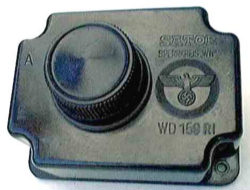 simple
attenuator embossed with the Party symbol that would pull in more distant stations on your
People's Radio. As the war progressed, fewer and fewer of these were allowed while penalties for
listening to foreign radio were increased to death. simple
attenuator embossed with the Party symbol that would pull in more distant stations on your
People's Radio. As the war progressed, fewer and fewer of these were allowed while penalties for
listening to foreign radio were increased to death.
And as the tide began to turn against Germany, and German news began to
dissemble more, the need to listen to some other voice increased.
Even with an ordinary People’s Radio, a little cleverness and a short length of wire
inserted at exactly the right points thru the back panel might satisfy an increasingly urgent quest for
news on which your whole future might rest. This story is told by a Croat
enlistee in the Wehrmacht stationed in Austria
in August of 1944: This story is told by a Croat
enlistee in the Wehrmacht stationed in Austria
in August of 1944:
…… we were attending a lecture on military strategies. A German
senior officer held it in a large room with maps on the wall. The officer’s face was badly
disfigured and his eyes looked at us sternly but with a certain sorrowful air. He had been explaining
the Allies' strategies on the
Normandy
peninsula and the possible options the Allies might have
for cutting
Normandy
off from the rest of
France
. Suddenly, one of my comrades said from the back of the
room: "It’s already happened!" Dead silence followed. After a few seconds, the officer
asked: "HOW DO YOU KNOW THIS? – THE SUPREME ARMY COMMAND (OKW) HAS NOT
ANNOUNCED THIS!" No explanation was necessary ‐ we sat there like wet, sodden dogs.
Later, back in our barracks room,
the People’s Radio's wire‐bridge had been carefully and quickly removed and stowed
away. Fortunately, there wasn't any inspection afterwards. (Lifestory ‐ http://www.cosy.sbg.ac.at/~zzspri/lifestories/vemp.html)
Was this a soldier likely to desert or surrender?
So Sefton Delmer was reaching into ordinary radios, even as far away as Austria . He would get
a transmitter which would make his grey and black radio propaganda projects some of the biggest, brightest
voices on German radio – even on the limited People’s Radio.
The Biggest Aspidistra in the World!
If you ever listen to radio these days, you’ve probably heard “50,000 watts clear
channel”. Today, as in the 1940s, it is still the maximum power allowed a US radio station. But in
1941, the RCA Corporation in New Jersey built for WJZ a transmitter 10 times more powerful. When the
Federal Communication Commission refused to lift its ceiling of 50,000 watts, the WJZ 500,000 watt
transmitter was briefly orphaned. Until the British heard about it.
The transmitter was crated up, shipped to the UK and installed in bombproof headquarters in Sussex.
They named it after a song sung by the English music hall entertainer, Gracie Fields: The Biggest
Aspidistra in the World!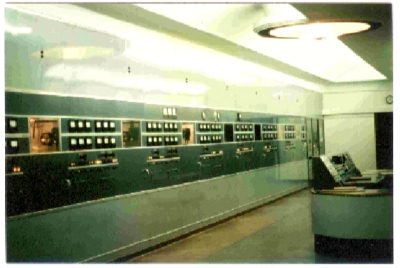
On the 8th November 1942 , this radio transmitter briefly took part in the invasion of
North Africa – but then it became largely the property of the BBC and white propaganda. (Photo by Felix Delmer appeared in "Black Propaganda" by Mark Kenyon
in issue No. 75 of "After the Battle"
Used with permission)
Since Sefton Delmer and PSE had been a major force in obtaining it from the United States, they, of
course, wanted to use it. By October, 1943, Delmer had a transmitter and a new station ready for prime
time.
Its purpose was to broadcast propaganda to Europe, the majority of which was under German occupation.
Above all, Aspidistra allowed Delmer to broadcast loud and clear to ordinary radio sets all over
Germany and German occupied Europe, including to Goebbels’ People’s Radios.
Soldatensender Calais
(Later Soldatensender West)
On shortwave at this time "Atlantiksender" had expanded its output and was broadcasting from
6:30 pm until 7 am
the following morning.
Meanwhile, "Soldatensender Calais" using the all‐powerful Aspidistra on
medium‐wave, began reaching an enormous audience in France, operating on a
frequency close to the German national "Deutschlandsender" home service.
The super‐powered signals sometimes drowned out all other nearby signals on the small
insensitive radio receivers issued to the German servicemen in
France
. The broadcasting hours of the station were gradually increased throughout late
1943 and 1944. By D‐Day ( 6th June 1944 ),
"Soldatensender Calais" was on the air from 8 pm
through 5 am.
German veterans of occupied
France recall that the PWE programmes had a seductive gloss. They were
convincingly couched in the slang of ordinary soldiers, and thanks to British agents in the field,
senior commanders and politicians were invariably referred to by their German nicknames, not all of
them complimentary…. All kinds of rumour, subtle innuendo, and disquieting inside information could
be included in supposedly patriotic talks and harangues in favour of the Fatherland. A favorite
theme was that German divisions stationed in France that were too combat‐ready were prime
candidates for the Eastern Front. (Lerner)
As the Allied invasion progressed, the breakdown in the Germans' field
communications became so grave that many of their commanders began tuning in to Soldatensender
Calais for situation reports, and using them to constantly update the changing order of battle
on their staff maps. The reports, obtained directly from SHAEF headquarters, were accurate 99 times
out of 100. The hundredth time came when some false information was inserted at the request of
tactical deception experts, to send the enemy headlong into a trap.
One incident at this time might show that the detail in the broadcasts was indeed listened to and
resulted in a specific capitulation. Soldatensender Calais had been dropping references to new
American ultra‐modern "superweapons" including talk of a new phosphorous shell that
could penetrate anything. The German General commanding the fort that blocked the advance onto the
Cherbourg peninsula insisted he was under orders to fight to the last man. Then, in negotiating a way
out the commander proposed that if the Americans could fire one of those new phosphorous shells, it
would prove his position was hopeless. The Americans fired an ordinary anti‐tank shell into the
wall of the fort. Good enough. The general trooped out with his men. (Delmer, Black Boomerang)
In late 1944, with the fall of Calais to the Canadians, "Soldatensender Calais" simply
renamed itself "Soldatensender West" and continued as before. It still had a lot more to say
on the progress of the war, and in its role as "spokesman for the decent fighting front line
soldier" was now demanding an end to the war, in order to save Germany. The target of the
Soldatensender's attack was now Hitler, who previously had never been criticized directly. The
station reported how he had been reduced to a shambling, nervous wreck, kept alive only by repeated
injections of drugs. Proclaimed a speaker on the station, "The enemy can wish for nothing better
than to have us led by a man who, in his conceit and ignorance, interferes in everything and
everywhere....A fellow like that is ‐ for the Allies, an ally." (The Biggest Aspidistra in the World! http://members.aol.com/skywave48/aspidistra.htm)
Deniability
You remember the "whispered wit" of the radio
listener's prayer. Another piece of whispered wartime wit in Germany, which may well have been
disseminated further by Delmer's gray and black radio, goes something like this:
It's Berlin, 1944, after a heavy bombing. A man,
tired of rationing and disaster, goes to a restaurant to get a good meal. "A bottle of
Riesling," he says.
The waiter shakes his head, "We don't have
any."
"Gewürztraminer?"
"Nein," the waiter says,
"No wine."
"All right," says the disappointed man, "Forget the
wine. I'll have an artichoke with butter, then a pork roast with string
beans."
"No more artichokes," says the waiter, "And no pork at
all."
On and on it goes. Whatever he wants, they don't have
it.
Disgusted, watched with annoyance by other diners, he finally asks for just a cigar and
a brandy.
The waiter is shaking his head before he even finishes asking. "No cigars.
No more brandy."
The man is furious. "Damn him!" he shouts,
slamming his fist on the table, "That blowhard bastard has destroyed this
country!"
Two stony‐faced men at the next table get up, identify themselves as
Gestapo, and place him under arrest. He asks loudly, "What did I do? Just got a little angry,
that's all!"
"You were complaining, slandering, we all heard you attack The
Führer!"
"I complained, yes, but ‐‐ attack The
Führer–?"
"You said that blowhard bastard has destroyed this
country!"
Glancing at his gawking fellow diners, he says, "Of course! That
blowhard bastard, Churchill, has destroyed our country!" Then to the Gestapo men,
" Who did YOU mean?"
English adaptation from a
German original by Philip S. Goodman
In other words, in a dictatorship, understanding or perhaps
misunderstanding is crucial.
So if you were listening to Black Radio and the fiercest
Nazi walked in on a dubious story, chances are that one minute later the radio would be giving straight
news from Goebbels' Ministry or a Hitler Speech. And chances are it was the clearest, loudest
station on the dial. Delmer stated his formula as "dirt, cover, cover, dirt, cover, cover...."
An email correspondent wrote me about his German school
in wartime, " To this day I remember some of us youngsters laughing behind our Greek language
instructor's back when he heard the loudspeaker blaring forth Calais stories in the school
hallway and he thought it was straight news."
Content
What else was in these broadcasts? Unfortunately, the destruction of the
scripts and recordings at the end of the war prevents me from giving you live examples.
However, the production of gray and black leaflets was also headed by Sefton
Delmer and there are indications that there was some coordination between the many millions of leaflets
dropped and the radio broadcasts of GS1, Atlantiksender and Soldatensender. Here are some
examples:
This booklet was called "Sickness saves" ... or can save your life.
Full of tips which radio could have used piecemeal, about how to get off duty when sick call comes
around. First principle: that the physician be convinced you're a patriotic citizen who has the
misfortune to feel bad. Second principle: Don't tell the doctor what you think is wrong...he must
discover it for himself as he drags the symptoms out of the patient.
This became THE underground work for the common soldier...and on both sides.
Goebbels had it translated into English and dropped by plane and artillery over Allied lines.
It's well known that millions of perfect counterfeit ration books were
dropped over Germany. They were so perfect that Goebbels purposely made crude copies of these ration
books, had them dropped on his own population so he could find people to arrest and hold up as examples
and warnings.
In the last year of the war, Nachrichten fuer die Truppe ‐ News for
the Troops ‐ was Delmer's most widely known publication. It was gray in the sense that it
never admitted it's origin ‐ providing a slim margin of "willing suspension of
disbelief" and of deniability. On one hand, it fell from Allied planes. On the other hand,
it's news reporting, like other gray and black products, was almost always impeccable.
I'm also showing here Goebbels' counter publication to
Nachrichten. The Lowdown, even in the last days of the Reich, kept up a fierce offensive against
the Allies.
Intrusion Operations This is a somewhat
different use of Black Radio. You might call in a tactical use. Or you might call it pure black radio. It
doesn't just pretend to be a legitimate, official station. It becomes the legitimate, official
station. And it can be quite unnerving to the listener.
My research turned up only two examples of intrusion operations, one the only example of Soviet
black radio operations I’ve come across and it's from an East German film based on the
autobiography of a German family in the east, presumably recounting true events:
A middle class Prussian family is seated on their terrace
and the very distant sound of Russian artillery is heard. They are listening to a German news broadcast.
Evacuations have briefly brought together a lot of the family members. Several are in uniform. On the
radio, the German announcer is giving a news item, something to the effect, "…a further
announcement from the Headquarters of the Fuehrer." Followed seamlessly, apparently by the same
announcer, "He's crazy, you know." And then the announcer, without dropping a beat,
continues the factual news item.
The family members don't even look at one another. But
one switches off the radio. Silence. Certainly no one will repeat what they all heard; the Gestapo would
misunderstand.
The pressures of war and evacuation, the loss of physical security, are clear in the closeups of the
faces ‐‐now reflecting on whether they've been brought to this point by a leader
who's crazy.
The business about "Nothing focuses the mind like facing the
hangman's noose" might characterize the dawning state of mind of many ordinary German
civilians and soldiers in 1944 and 45.
While it's been clearly shown that in 1940, '41 and '42 the vast majority of Germans
became enthusiastic about Hitler. Even those who had not supported him at the beginning, became
adherents, especially with the victories in France and Russia.
With the beginning of the collapse in 1944 and 45, the Allies faced the problem of how to avoid an
endless series of Nazi redoubts. In '40 and '41, they had seen the fanatical determination on
the faces of the cheering German crowds. The power of the Aspidistra, now boosted from 500,000 watts
to 600,000 watts, was used for a somewhat different purpose in 1945, you might say tactically, for a
series of Intrusion Operations. This was black radio in the extreme, where it literally took over Nazi
broadcasts on the same frequency.

On the evening of 30th March
"Aspidistra" intruded into the Berlin
and
Hamburg
frequencies warning that the Allies were trying to
spread confusion by sending false telephone messages from occupied towns to unoccupied towns. The
message advised that, from now on, any instructions or reports received by telephone should not be
believed or acted upon immediately, but should be confirmed by telephoning the supposed source of the
call. This instruction, if fully followed, would seriously delay the carrying out of orders and place
extra strain on the already half‐crippled German telephone network.
On the evening of 8th April, "Aspidistra"
intruded into the
Hamburg
and
Leipzig
channels to warn of forged banknotes in circulation. Then, on the following evening, there
were announcements encouraging people to evacuate to seven bomb‐free zones in central and
southern
Germany
, where it was claimed that they would be safe from further enemy air attacks.
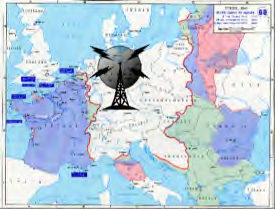 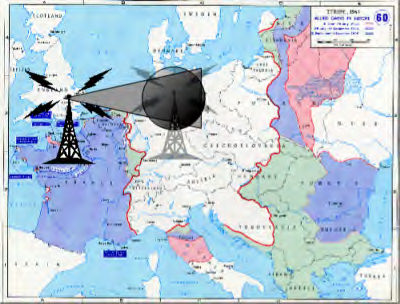
Maps produced by the author
from maps at the United States Military
Academy Digital Library digital‐library.usma.edu/collections/maps/wpmaps/
The Germans tried to mount a defense into these intrusions.
The following announcements were continuously broadcast by the German radio stations:
"The enemy is broadcasting counterfeit instructions on our
frequencies. Do not be misled by them. Here is an official announcement of the Reich
authority."
But, of course, exactly the same announcement began to precede all bogus
messages broadcast by "Aspidistra" too! "The
enemy is broadcasting counterfeit instructions on our frequencies.....Here is the
official....."
Epilogue
One might argue, at least about earlier gray
and black ops, that because there was so little real
German resistance to the Nazis, the British
had to invent some.
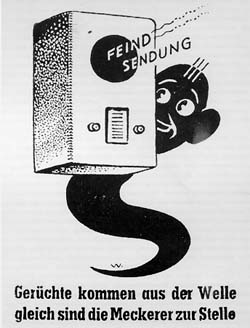
|
German flyer
Enemy broadcast
Rumors come out of the airwaves like complainers come out of the
woodwork.
|
|
|
Delmer knew the German mind of the time well. The star of GS1, Der Chef, was a conformist, a
Prussian aristocrat, with a title Der Volk would look up to. But he also represented the complainer, the
malcontent that some said underlies the German character. In the early 30s, when Delmer toured as a
British correspondent with Hitler’s entourage, Hitler took Delmer aside on occasion, and declared
how he wanted an alliance with the British, but would also tell Delmer about his view of the
“Schweinhund” or pig‐dog, in every man.
“With the help of a clever persistent propaganda, even heaven can be represented to the
people as hell, and the most wretched life as paradise." Hitler said in Mein Kampf. While I
don’t think you could say that British radio psyops were Nazi inspired, Delmer’s enthusiasm
might have stemmed from his knowledge of Goebbels Radio Concordia as well as making sure the Nazis got a
taste of their own medicine.
Goebbels knew that propaganda, especially gray and black propaganda, was a double‐edged
sword. His diaries often express concern that a wedge would be driven between the Nazi Party and the
German people.
Toward the end of the war, the Soviet Armies approached Germany’s
eastern borders. The world began to hear Ilya Ehrenburg’s Soviet motto, “Comrade, kill your
German!” A grim witticism, probably disseminated further by gray and black radio, was regularly
whispered among the German populace: “Enjoy the War. Peace will be terrible.”
One thing we have NOT dealt with here is the morality of gray and black radio. Is it a fair weapon
of war? On one hand, is it more or less moral than an artillery shell? Or, does it corrupt both the
parties on the sending and the receiving end and history too, in the way some would maintain that English
propaganda at the end of World War I set the stage for the
"stab‐in‐the‐back" theory and thus the rise of the Nazis.But,
believe it or not, the brains behind British gray and black radio did have a moral crisis in the
war's aftermath. In his aptly titled Black Boomerang, Sefton Delmer worried that his gray and
black radio operations helped to build up the myth of a good anti‐Nazi Wehrmacht.In the
1970s, the Watergate era with revelations about dirty tricks, newspapers & journals, especially in the
UK, carried many references to WW II gray and black operations in relation to political dirty tricks in
British and American politics.There were intimations, at least in principal, that a nation could
obtain victory in war, and yet suffer defeat in peace.
Gray & Black Radio
Today And today? Are there any more gray or black radio ventures?
You bet:
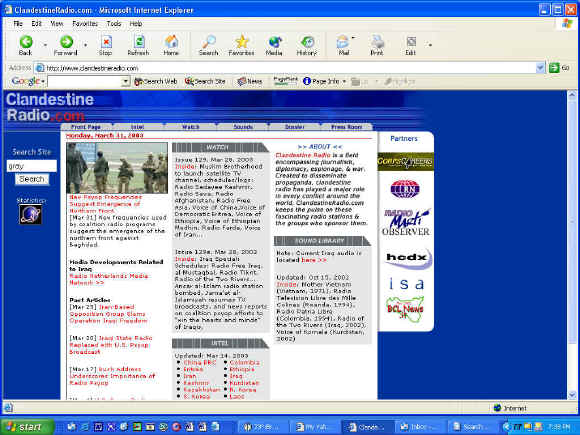
Clandestineradio.com
Clandestine Radio.com. This well‐managed, in‐depth website keeps track of past and
current pirate radio including gray and black radio. A site search on gray or black will show recent
activities around the globe; in Ireland, Cambodia, Afghanistan, and, yes, Iraq.
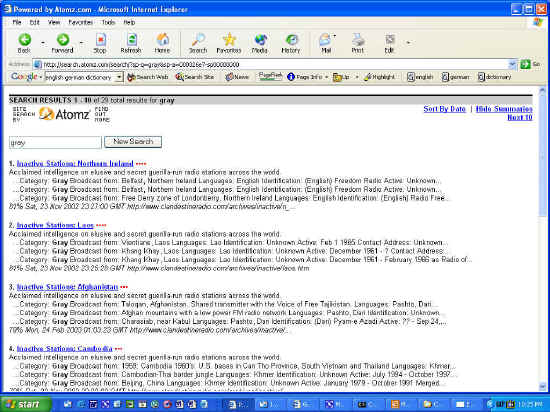 This is from correspondence I had from Nick Grace, founder of Clandestineradio.com, at the time of the Iraq invasion:
This is from correspondence I had from Nick Grace, founder of Clandestineradio.com, at the time of the Iraq invasion:
Reading through (your paper) I am often
reminded of the techniques utilized by the Bush administration to "soften" Baghdad and the
Iraqi military in the months, days, and hours leading to Operation Iraqi Freedom. It's clear that
Washington looked back to the British efforts during WWII against Germany, including intrusion and the
surreptitious phone calls. In addition, I would add as well the Atlantiksender's use of
personality to gain the listener's trust and empathy. This is evident nowadays with al Mustaqbal
(The Future) and Radio Tikrit, both funded by the CIA and staffed by members of the Amman‐based
Iraqi National Accord. (These two stations targeted military officers and Ba'ath Party
loyalists.)
Radio Tikrit is a black station... al Mustaqbal is gray. Both are tied to a
group called Wifaq (Iraqi National Accord) that's favored and funded by Langley (the CIA).
The history of the uses of gray and black, especially in the enormously successful efforts
to get the Iraqi officer corps to "just walk away" during the 2003 invasion, has yet to be
written.
Conclusions
I emphasize again that there are certainly no scientific conclusions to be drawn, much less
than, say, the Strategic Bombing Survey where destruction is measurable but the effect
on the outcome of the war is debated to this day.
SOE actually had plans to do surveys in May, 1945 but it was dropped with the same spirit that the
documents and recordings were systematically destroyed and Delmer’s staff were reminded that
they had all signed the Official Secrets Act.
During the war, Delmer continually obtained feedback and new tidbits by bugging the British cages of
German prisoners. The POWs were extensively monitored both for tidbits like insider‐gossip from
submariners for Atlantiksender and feedback on what they believed. Also, these bugs revealed what
“those‐in‐the‐know” thought and said. The sociological mechanics of
almost any group could guarantee the alpha personality who would have “the real story”
Here's a family snapshot that's always fascinated me: apparently a German family or
neighbors in their air raid shelter, 1944 or '45?. That's probably a People's Radio on
the right. In this group, indeed in any group you know, aren't there several "alpha"
personalities? The ones who know better, have the details and have the truth, rise above the common
wisdom, know the insider info and take a kind of mental leadership of the group.
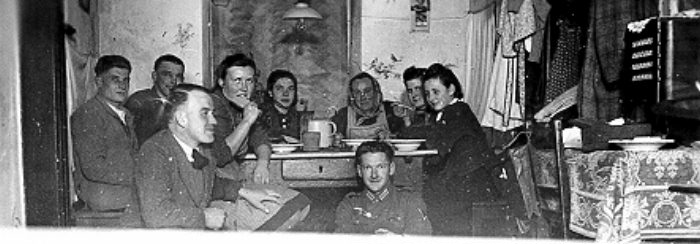
Photo from The Decline and Fall of Nazi Germany
and Imperial Japan, The. Dollinger, Hans. Crown : New York. 1968
This, I think, is the difficult‐to‐define
sphere of human nature and of attitude change we seldom intellectualize. Is it possible that
Delmer's great insight was into this sphere? Either one or two of these people might be assiduous
listeners to GS1 and Der Chef or to Soldatensender. Or if they are all so beaten down
with bombings and threats to their physical security, perhaps the radio itself is the alpha character
in this group.
Again, our evidence is anecdotal. Some who've written on the subject say that Gray and Black
propaganda efforts were a joke and a waste of time (Learner & Crossman), while other speculate
that Gray and Black might even have been an insidious motivator for the July 20th plotters against
Hitler or even added to Hitler's paranoia about the loyalty of the military caste (Delmer, Jolly
and Howe).
Morale is sometimes defined as "the ace in hole" in wartime: the factor that lets you win
when supplies, weather, or the numerical superiority of the enemy say you should lose. Eisenhower
convened his Committee on Methods of
Breaking the German Will to Resist in November of 1944 to try to figure out why German morale was not yet broken.
Perhaps a better word than morale is will
or heart. As in giving your heart or heartbreak or to lose
heart.
In conclusion, I give you two more documents from the two years that followed Goebbels' 1943
diary entry about "the very clever job of propaganda" done by Delmer's black
Soldatensender.
In 1944, from a Wehrmacht General:
|
Headquarters,
5 Feb. 44 .
Commanding General
709th Inf. Div.
SUBJECT: Questions of leadership and Moral
Defensive Measures against Enemy Propaganda
TO: Commanding Officers of Regiments and
Battalions
1. The enemy is trying, with unheard‐of
hatred, with ever‐changing tricks and ruses, with lies and falsehood and with
everything however mean, to undermine the morale of the German people and to force a
decision on the “battlefield of the war of nerves,” just as he did in the First
World War. In the West, the efforts of the enemy agitators have been intensified from month
to month. I need only mention the dangerous propaganda broadcast by the provocative enemy
station “Soldatensender Calais.” (bold face mine)
|
Toward the end of the war, a Gauleiter
(Nazi district boss) wrote to the military:
|
Gauamtsleiter
29 March ‘45
General:
“Unless something outstanding and
positive for Germany occurs within the next few
days, we are faced with catastrophe. . . This… is the effect the dramatic war situation in
the West has had on the morale of the population.
Rumours, strengthened through enemy radio
announcements in German transmissions, do all that remains to finish off the fighting
spirit of the Army and the endurance of the people.”
|
Sefton Delmer turned information
into a weapon itself – flexible, amazingly adaptable, furtive, dangerous to an enemy, yet
‐‐ dare one say it in the context of war's destruction? ‐‐
entertaining is a sense to both those who were targeted and those who used it.
There's a line by Clausewitz in his Chapter "Information in War":
A great part of the information obtained in war is
contradictory,
a still greater part is false,
and by far the greatest part
is
of a doubtful character.
Clausewitz On War
Chapter VI Information in War
www.clausewitz.com/CWZHOME/On_War/BK1ch06.html
|
So it might be safe to say that Sefton Delmer, who would never lie
by accident, is honored by Clausewitz's statement.
_____________end _______________
Introduction | Anecdotal Evidence |
Definition of Terms | History
& Evolution | Sefton Delmer
The People's Radio | Gustav
Siegfried Eins | Atlantiksender | Reception ‐ a crucial issue
The Biggest Aspidistra in the World! | Soldatensender Calais | Deniability |
Content
Intrusion Operations | Epilogue | Gray & Black Radio
Today | Conclusions | About the author |
Bibliography & Acknowledgements

Bob Rowen has been a board member of the New York Military Affairs Symposium for almost five years. He is a
studio photographer, a webmaster of over 50 sites on the Internet, and a computer consultant to
libraries. He has given NYMAS papers on "Researching Military History on the Web" ,
"American Privateers in the War of 1812" and is preparing a new paper entitled
"Civil War Music: Grand, Glorious and Grim"
Bob served in the US Army in
postwar Germany reporting from Munich, Augsburg and Berlin for the American Forces Network. He
helped launch this organization's website nymas.org which is
rated one of the top 10 resources on Wars and Conflicts on the Web by both Google and the Open
Directory Project.
With tonight's paper, he
is sensitive that there might be a concern that NYMAS's webmaster is a student of lies,
disinformation, rumors and tricks. He would like to assure all that he truly believes in 100%
accuracy for facts and in calling speculation just that.
The author is delighted to get
questions, contributions, comments or concerns about this paper at
rrowen@nymas.org
|

 Propaganda added to its domestic and international
services a third section: Bureau Concordia. As the Phoney War evolved into the conquest of France, the
French heard unidentified radio stations which seemed to be Communist urging pacifism and peace and
messages that “France was weak, Germany was strong, and Britain was using France for its own
imperialist purposes (Bergmeier & Lotz) The station would
"reveal" deficiencies in the French armament industry and express concern for the
country's future if the army lost their spirit.(Photo from the
Why We Fight Series, The Nazis Strike, OWI/US Signal Corps, 1943)
Propaganda added to its domestic and international
services a third section: Bureau Concordia. As the Phoney War evolved into the conquest of France, the
French heard unidentified radio stations which seemed to be Communist urging pacifism and peace and
messages that “France was weak, Germany was strong, and Britain was using France for its own
imperialist purposes (Bergmeier & Lotz) The station would
"reveal" deficiencies in the French armament industry and express concern for the
country's future if the army lost their spirit.(Photo from the
Why We Fight Series, The Nazis Strike, OWI/US Signal Corps, 1943)

 This story is told by a Croat
enlistee in the Wehrmacht stationed in Austria
This story is told by a Croat
enlistee in the Wehrmacht stationed in Austria

![]() Return to the New York Military Affairs Symposium start page
Return to the New York Military Affairs Symposium start page 









 limited to AM (plus the Lower frequency European Longwave) and not very good at receiving the more
distant stations.
limited to AM (plus the Lower frequency European Longwave) and not very good at receiving the more
distant stations.
 simple
attenuator embossed with the Party symbol that would pull in more distant stations on your
People's Radio. As the war progressed, fewer and fewer of these were allowed while penalties for
listening to foreign radio were increased to death.
simple
attenuator embossed with the Party symbol that would pull in more distant stations on your
People's Radio. As the war progressed, fewer and fewer of these were allowed while penalties for
listening to foreign radio were increased to death.

